
Introduction to carbohydrates (saccharides). Monomers and polymers. Glucose and glycogen.
- Subject:
- Biology
- Life Science
- Nutrition
- Material Type:
- Lesson
- Provider:
- Khan Academy
- Provider Set:
- Khan Academy
- Author:
- Sal Khan
- Date Added:
- 02/28/2018

Introduction to carbohydrates (saccharides). Monomers and polymers. Glucose and glycogen.

Introduction to lipids like fats and phospholipids.

Introduction to proteins as polymers of amino acids (monomers).

Overview of common vitamins and minerals that are important to human health.

This is an introductory jumproping lesson for grades K-2. It includes a breakdown of what jumproping is, an individual practice, as well as a group game. This lesson focuses on the benefits of jumproping and why it is a good exercise.
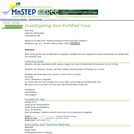
After studying that iron is attracted to magnets, students will use magnets to extract food-grade iron filings from iron-fortified food.
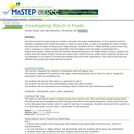
This activity is a classroom experiment where students gather data on which foods contain starch. They use observation and develop their own hypothesis to create a question they would like to discover about starches.
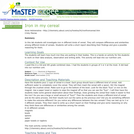
This activity is a hands on activity where students will gather information on their findings about iron in different cereals. Then use their finding and give reasonings of the differences and similarities.
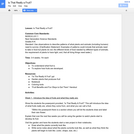
Objectives:
To understand what fruit is.
To explore how fruits are developed.

This resource is a video abstract of a research paper created by Research Square on behalf of its authors. It provides a synopsis that's easy to understand, and can be used to introduce the topics it covers to students, researchers, and the general public. The video's transcript is also provided in full, with a portion provided below for preview:
"Today's obesity epidemic is driven by increased consumption of foods that are high in fat and low in soluble fiber, which alters the makeup of the gut microbiome. These changes also vary by age and sex, causing differences in susceptibility to obesity. Unfortunately, most animal studies compare diets that vary in both fat and fiber, making it difficult to determine which has an effect. Now, a new study suggests that fiber could play the more prominent role. The authors of the study profiled the microbial community in mice fed diets varying in either fiber or fat, but not both. 16S rRNA sequencing revealed that changes in fiber accounted for most of the variance in microbes. While these changes were age- and sex-specific, they were not dependent on dietary fat. Although further studies are needed to fully understand these effects, the results suggest that in animal obesity studies, the choice of control diet matters..."
The rest of the transcript, along with a link to the research itself, is available on the resource itself.
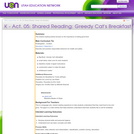
This shared reading activity focuses on the importance of eating good food.
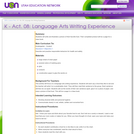
In this lesson students will write and illustrate a picture of their favorite food. Their completed product will be a page for a class book.
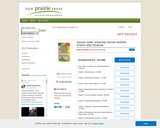
The Kansas State University Human Nutrition (FNDH 400) Flexbook is a textbook for students taking Kansas State University FNDH 400 course.FNDH 400 is a 3-hour, intermediate-level, human nutrition course at Kansas State University take primarily by sophomores and juniors because it has prerequisites of a college biology and chemistry courses.

This resource is a video abstract of a research paper created by Research Square on behalf of its authors. It provides a synopsis that's easy to understand, and can be used to introduce the topics it covers to students, researchers, and the general public. The video's transcript is also provided in full, with a portion provided below for preview:
"The ketogenic diet may be one of the hottest trends in weight management, but doctors have long known of its potential to reduce seizures in those with epilepsy. In a new article in Physiological Reports, scientists suggest that strict adherence to the diet may not be needed to achieve this neuroprotective effect. Through a series of experiments in rats, they show that supplementing a normal, carbohydrate-rich diet with specific ketogenic agents may significantly delay seizures. The team specifically focused on tonic-clonic seizures caused by exposure to high levels of oxygen. This central nervous system oxygen toxicity is a complication that can arise following hyperbaric oxygen therapy, which involves inhaling pure oxygen in a pressurized or hyperbaric chamber. This kind of treatment is used to manage various medical conditions, including air/gas embolism, decompression sickness, carbon monoxide poisoning and diabetic wounds..."
The rest of the transcript, along with a link to the research itself, is available on the resource itself.
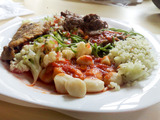
la descripción de los alimentos es para visualizar su importancia, especialmente, en Guatemala ya que no se da la debida importancia a este tema, vital para el desarrollo del pais, por las diferentes caracteristicas de los alimentos.

Šī informatīvā grāmata ir no Vašingtonas Universitātes Latviešu valodas pirmā gada kursa, 2023.
Word Count: 2279
(Note: This resource's metadata has been created automatically as part of a bulk import process by reformatting and/or combining the information that the author initially provided. As a result, there may be errors in formatting.)

A patient discusses diabetes and how he manages his carbohydrate intake in this video segment from TV 411.
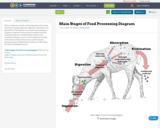
This is a diagram visually summarizing the main stages of food processing: ingestion, digestion, absorption, and elimination. This diagram was created to accompany a chapter on digestion and nutrition modified from the OpenStax Anatomy and Physiology textbook for a nonmajor's biology course.
It was modified for biology instruction by Tina B. Jones from a public domain drawing posted to Wikimedia Commons by Tom Kelly, U.S. Fish and Wildlife Service.
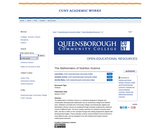
The Mathematics of Nutrition Science is a workbook designed to integrate and contextualize developmental mathematics into an introductory college level Nutrition class. Definitions and skills from Community College Level Elementary Algebra and Quantitative Literacy courses are explained through examples analyzing the nutritional content of different foods. The book contains exercises for students to practice these skills, and also to reflect on the concepts through short writing assignments aligned with developmental English. These materials could be used by Nutrition course instructor in many different ways, and are designed to be self-contained and require minimal mathematical instruction.

This resource is a video abstract of a research paper created by Research Square on behalf of its authors. It provides a synopsis that's easy to understand, and can be used to introduce the topics it covers to students, researchers, and the general public. The video's transcript is also provided in full, with a portion provided below for preview:
"Crohn’s disease is a chronic inflammatory disease of the gut whose presence throughout the globe is rising including among children. One contributing factor is believed to be the spread of the high-fat, high-sugar Western diet. A recent study confirmed this link in mouse pups artificially induced to develop Crohn’s disease. Researchers found that compared with mouse pups that were raised on a normal diet and were born from mothers fed a normal diet, pups from mothers fed a Western-style diet showed more severe signs of disease. Metagenomics revealed that these sicker mice harbored significantly more Bacteroides bacteria in their gut which was accompanied by the accumulation of deoxycholic acid, a secondary bile acid linked to inflammation. In fact, when administered to mice in separate experiments, deoxycholic acid was found to aggravate signs of Crohn’s disease. While it’s unclear whether the same biochemical effects occur in humans, the findings offer an important message..."
The rest of the transcript, along with a link to the research itself, is available on the resource itself.